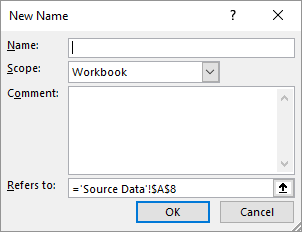Please Note: This article is written for users of the following Microsoft Excel versions: 2007, 2010, 2013, 2016, 2019, 2021, 2024, and Excel in Microsoft 365. If you are using an earlier version (Excel 2003 or earlier), this tip may not work for you. For a version of this tip written specifically for earlier versions of Excel, click here: Running a Macro When a Worksheet is Deactivated.
Written by Allen Wyatt (last updated January 3, 2026)
This tip applies to Excel 2007, 2010, 2013, 2016, 2019, 2021, 2024, and Excel in Microsoft 365
It is possible to configure Excel so that a macro of your choosing is executed every time a particular worksheet is deactivated. What does that mean? Simply that a macro can be run every time you click on a worksheet tab to leave the current sheet. There are two ways you can do this. Here's the first method:

Figure 1. The New Name dialog box.
The second method is to rely on the Worksheet_Deactivate event. Right-click the worksheet's tab (at the bottom of the Excel window) and choose Code Window from the resulting options. This opens the Visual Basic Editor and you can then put the following into the Code window:
Private Sub Worksheet_Deactivate()
Call Update_PL
End Sub
This, again, assumes that the macro you want to run is called Update_PL. You can then close the Visual Basic Editor.
Remember that the macro you set up using either of these approaches is run every time the worksheet is deactivated, not just the first time. Think about how you use Excel; if you spend a fair amount of time hopping between worksheets in a workbook or between workbooks, it is possible to deactivate a worksheet several dozen times during the course of a session.
Note:
ExcelTips is your source for cost-effective Microsoft Excel training. This tip (6138) applies to Microsoft Excel 2007, 2010, 2013, 2016, 2019, 2021, 2024, and Excel in Microsoft 365. You can find a version of this tip for the older menu interface of Excel here: Running a Macro When a Worksheet is Deactivated.

Create Custom Apps with VBA! Discover how to extend the capabilities of Office 365 applications with VBA programming. Written in clear terms and understandable language, the book includes systematic tutorials and contains both intermediate and advanced content for experienced VB developers. Designed to be comprehensive, the book addresses not just one Office application, but the entire Office suite. Check out Mastering VBA for Microsoft Office 365 today!
Want to print a document by using a macro? One way is to display the Print dialog box and allow the user to interact with ...
Discover MoreWant a quick way to jump to the end of your data entry area in a worksheet? The macro in this tip makes quick work of the ...
Discover MoreMacros are often used to process the data in a worksheet. If that data includes dates that need to be processed, you'll ...
Discover MoreFREE SERVICE: Get tips like this every week in ExcelTips, a free productivity newsletter. Enter your address and click "Subscribe."
2026-01-04 10:08:41
J. Woolley
@Dave Bonin
"Is there a list of the available events available?" Please experiment, make a list, and let us know.
2026-01-03 12:45:58
Dave Bonin
I had never seen the [worksheet]!Auto_Deactivate with a defined name approach before.
Is there a list of the available events available?
Any idea on which approach is better and when:
1) [worksheet]!Auto_Deactivate with a defined name
2) Worksheet_Deactivate event
Got a version of Excel that uses the ribbon interface (Excel 2007 or later)? This site is for you! If you use an earlier version of Excel, visit our ExcelTips site focusing on the menu interface.
FREE SERVICE: Get tips like this every week in ExcelTips, a free productivity newsletter. Enter your address and click "Subscribe."
Copyright © 2026 Sharon Parq Associates, Inc.
Comments